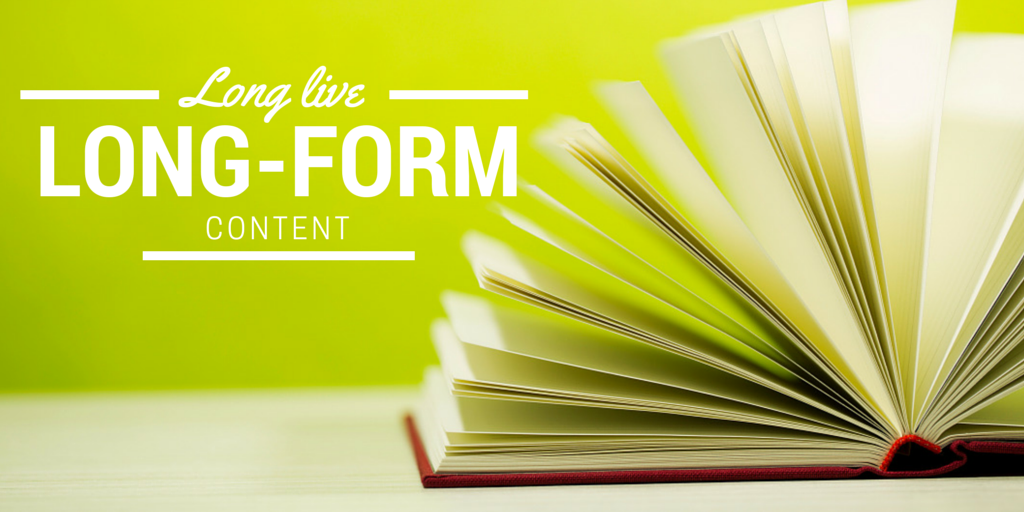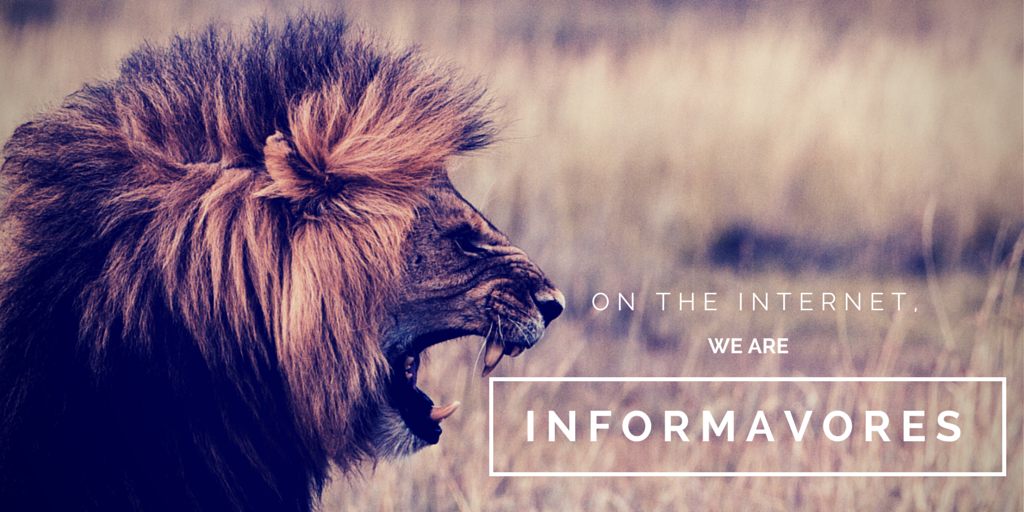Why longer content works in today’s 140-character, soundbite, snackable, tweet-frenzied world
 How many times have you heard that no one reads anything longer than a 140-character tweet anymore? That our attention spans are shot due to digital information overload, multi-tasking and multi-channeling? That if you create anything longer than 200 words or 30 seconds no one will pay any attention to it? Soundbites! “Snackable” content! Tweets!
How many times have you heard that no one reads anything longer than a 140-character tweet anymore? That our attention spans are shot due to digital information overload, multi-tasking and multi-channeling? That if you create anything longer than 200 words or 30 seconds no one will pay any attention to it? Soundbites! “Snackable” content! Tweets!
Wrong. Wrong. Wrong. (Well, except for the attention-span thing.)
While technology has certainly changed the way we think and process information, people still desire substantial information. They just consume it differently. In fact, due to the overwhelming glut of content available on the Internet today, Internet users are becoming more discerning about the content they consume, searching and scanning for content that’s worth their attention and time, and engaging more heavily with valuable, lengthy content. And in the online world — where everyone can be a publisher — the way to distinguish yourself is by producing an outstanding piece of substantial content that stands out from the rest.
What’s a content marketer to do?
While short content certainly plays an important role in the buyer’s journey (or funnel, whatever your terminology), you cannot ignore long-form content. To meet buyers’ increasing demands for meatier, weighty, informative content, you must create substantial, lengthy content (in the written form, long-form is typically considered anything over 1,200 words). You cannot simply create shallow, short pieces with very little substance on the premise that you are delivering what today’s mentally frazzled buyers will only consume.
And, because they are mentally frazzled (and they certainly are), it’s critical that your content be presented in a clear, succinct and concise way, and that you give your buyers the opportunity to consume the information in whatever way suits them best.
Go long, yet concise. Huh?
What’s the difference between long and concise? Substantial information will often inherently mean longer content (although not always). Original research, data, examples, case studies, scenarios, technical descriptions, historical references, and more are incredibly valuable and help you build trust and establish yourself as an expert in your field. However, this information doesn’t have to be written or presented in ways that are difficult to read.
When writing lengthy content, make sure every single word adds value. Be ruthless with your editing pen. Here are a few tips to ensure your writing is concise and clear:
-
Omit unnecessary detail
-
Keep the average sentence length below 25 words
-
In most sentences, put only one main thought
-
Use mainly active voice
-
Use concrete words, not abstractions
-
Use headings and topic sentences to summarize the main idea of paragraphs
-
Use lists and bullet points
It’s a jungle out there, so make it scannable (and visual and mobile)
Our attention spans are now shorter than a goldfish’s. But that doesn’t mean we don’t want deep, substantial information. We just want to find the good stuff, fast.
According to web usability expert Jakob Nielsen, who writes on topics such as eye-tracking research, Web design errors, and banner blindness, humans are informavores. On the Internet we hunt for facts. We assess a site quickly, looking for an “information scent.” If we don’t find it, we quickly move on. If we find it, we stay and eat. Nielsen calls this “information foraging.”
 To address this wild-beast-like behavior, content marketers must create content that is scannable (think subheads, bullet lists, etc.) and visually appealing (no more white papers, but highly visual e-books). In a previous blog post, we mentioned that 65 percent of us are visual learners and that the brain processes visualization 60,000 times faster than words on a page.
To address this wild-beast-like behavior, content marketers must create content that is scannable (think subheads, bullet lists, etc.) and visually appealing (no more white papers, but highly visual e-books). In a previous blog post, we mentioned that 65 percent of us are visual learners and that the brain processes visualization 60,000 times faster than words on a page.
Abstracts or previews should be written to enable readers to quickly discern whether it’s worth engaging with the content on a deeper level. And, with Google’s latest update, mobile-optimized content has become mission-critical.
Tell stories, give solutions
Two more ways to always win with long-form content: tell stories and give solutions.
Why do we like stories so much? A University of Texas study looked at the ways our brains retrieve information when faced with a choice. Instead of a generalized overview of past experiences, the brain retrieves specific traces of memories. Other studies show that storytelling evokes a strong neurological response. No matter the science, storytelling works.
Helping also works. When searching the Internet, we are looking for solutions to our problems. For example, Moz’s free Beginner’s Guide to SEO (packed with actionable tips) has been visited over 1 million times and been linked to more than 36,000 times. When you create your content, ask whether you’ve provided value. Did you answer questions, provide advice, or give solutions? If not, go back and do so.
Still not convinced? Here are a few more articles on the topic:
5 Things That Will Change Your Mind About Long Form Content Marketing — CoSchedule Blog
Improve Your Content Marketing with Long Form Content — BuzzSumo
5 Reasons Why Long Content and Blog Posts Are Once Again the Future of Content Marketing — The Sales Lion
How Content Length Affects Rankings and Conversions — Quick Sprout
Why Long Copy and Content Ranks Better in Google’s Results — blur Group
Had any success with long-form content? I’d love to hear your thoughts. Comment below or send me an email at michelle@rep-ink.com.








Informavores – fascinating term you taught me today Michelle – thanks.
And speaking of long-form, your link led me here http://www.nngroup.com/articles/information-scent/ which I read all the way through.
Thanks Mike! Jakob Nielsen’s blog is incredibly informative — we are regular readers.